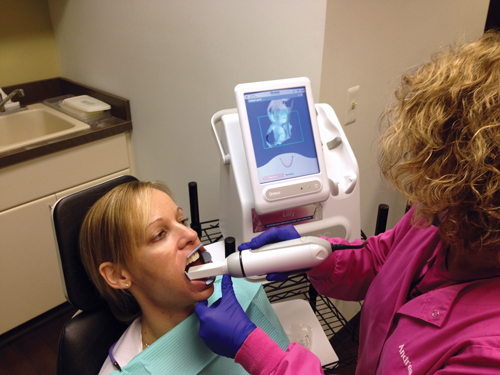By Jamie Reynolds, DDS, MS
Advances in orthodontic technology are researched and developed for more comfortable and efficient treatment, while simultaneously helping doctors streamline practice operations. The goal is, for us doctors, to have patients that are exceedingly happy and a profitable practice that runs smoothly. Today, we are seeing the evolution of technology and a push toward digital practice tools. Orthodontic practices (including mine) are transitioning from traditional to digital processes, and for good reason.
PVS impressions are one of the three biggest treatment pain points I see with patients today, alongside permanent teeth extraction and headgear. Patients are vehemently against all of them. The PVS material gags patients, and it is an overall uncomfortable and messy process. Moreover, when patients squirm or move while taking a PVS impression, it can ruin the mold, which requires us to start again—and sometimes, again and again. This can come off as torture, and we never want to subject patients to something they so greatly dislike.
The good news is, with cutting-edge scanning technology, we can eliminate the loathed traditional impression process.
I was first introduced to digital intraoral scanning several years ago when Ormco™ was conceptualizing its Lythos™ Digital Impression System. Lythos is a lightweight unit that offers a powder-free scan, captured by moving an ergonomic wand around the patient’s mouth. The scanner uses video technology to gain real-time impression data for all intended appliances and records. So what are the benefits of such technology? No PVS material, less eventual costs, higher accuracy, and happier patients and staff.
However, the decision to leave behind PVS impressions and make the transition to a digital workflow can seem overwhelming, expensive, and both labor- and time-intensive. With our practice fully transitioned, the following article will walk through how we successfully adopted digital scanning—without breaking the bank or upsetting staff—and share tips for those of you considering a digital scanner for your practice.
Implementation
Our practice received one of the very first Lythos scanners, and like any technology, there was a learning curve. You remember office Rolodexes, right? The transition from desk-side card indexes to address books on computers and cell phones is quite similar to the transition from PVS impressions to digital intraoral scanning. It’s new territory that requires adaptability and a positive attitude. That said, the digital touch screen is intuitive, so anyone with a smartphone can grasp the software fairly quickly. With a color-coded scan system, technicians can easily tell when they are capturing enough data and when they need to move closer to the tooth surface.
Additionally, we had a trainer come out to install the machine, and he was able to teach us the ins and outs of the device and answer any questions staff had. Nowadays, it doesn’t take more than a few times practicing before one of our employees is able to properly scan patients. Note, this is significantly quicker than the time it takes to learn how to do a PVS impression.
Through our experience, here is what we learned:
- Communicate the benefits and importance of digital scans to ensure your staff is on board and behind you.
- Assign a team lead to work with the trainer and have them learn all about the product, and how to properly use it for future staff training purposes.
- Dedicate time outside work—perhaps a half hour before, or after hours—to have the team lead brief your staff on the new product.
- Practice, practice, practice. Assign your staff practice hours scanning stone models to become more efficient.
It’s No Gallon of Milk
PVS is a flawed material. Any orthodontist that has aligners or jigs fabricated knows they fit significantly better using a digital intraoral scanner. The improvement from PVS impressions is unquestionable. Nevertheless, buying a scanner isn’t like buying a gallon of milk—it’s an investment.
Albeit worthwhile, I recommend spending time with your practice budget to ensure you can support the upfront cost. After assessing the initial cost and rebates, we determined that our practice could offset the cost of a Lythos with PVS material because there are no lab fees.
Most notably, though, Lythos has a unique rebate program in which all scan data used for select digital Ormco products earn you a rebate toward the payment of your Lythos. The more cases you do, the more you earn—and there is no limit. Moreover, if your rebate totals more than your payment, Ormco will issue a credit to your account. With a program like this, eventually, Lythos can cost you $0—or make you money—and for our practice, which treats a number of cases with Insignia™ Advanced Smile Design™, this rebate has nearly eliminated costs associated with the purchase.
Another important factor to consider when assessing the financials is that there’s a lot of money to be made for orthodontists who adopt digital scanning and offer patients PVS-free treatment. Our practice has experienced significant demand from patients who are willing to pay extra for PVS-free treatment. I could list at least 10 patients who have said they chose our practice because of the option to not have PVS impressions.
As you take a look at the books, here are a few things to keep in mind:
- Research the rebate options. Rebate savings can really add up.
- Consider the added revenue that could be generated; talk with your colleagues in other regions and see if they are experiencing a demand for PVS-free treatment.
- Don’t forget the intangible benefits. Consider how going digital will impact your practice brand/reputation.
- When creating a cost comparison, factor in all associated fees—supplies costs, lab fees, software updates, storage fees, etc.
Keep in mind, if there are a variety of dental and orthodontic practices in your area offering orthodontic treatment, having a differentiator that addresses a huge patient pain point will help make your practice stand out.
Conclusion
Transitioning to a digital scanning process is not a decision to take lightly, but it’s also not a decision to shy away from. Integrating this technology has allowed our practice to grow closer with patients, provide them with better experiences, and boost our profitability. OP










